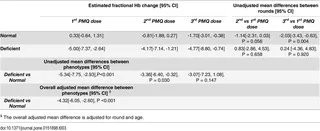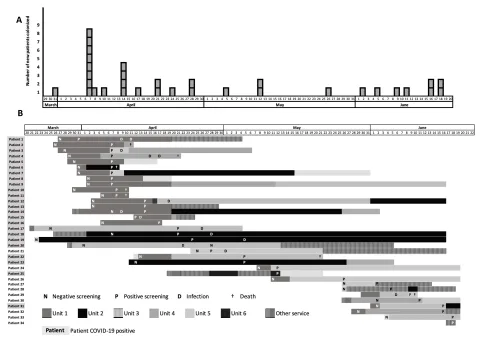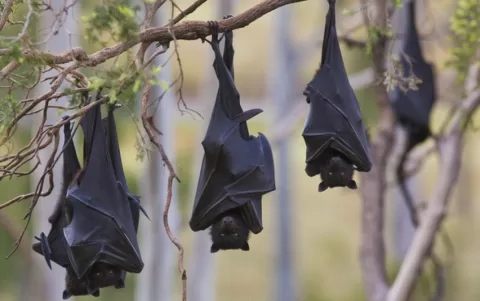Low-dose primaquine is emerging as a pivotal intervention in the fight against malaria, particularly in young children, who are disproportionately affected by this deadly disease. Recent studies indicate that the integration of low-dose primaquine into malaria treatment regimes, such as artemisinin-based combination therapy (ACT), significantly reduces the transmission rates of *Plasmodium falciparum* malaria. This advancement aligns with the World Health Organization’s (WHO) recommendations to combat malaria transmission and address rising concerns about artemisinin resistance. By effectively eliminating gametocytes in infected individuals, low-dose primaquine not only protects vulnerable young populations but also plays a critical role in preventing malaria transmission to mosquitoes. As global health initiatives continue to evolve, the promise of low-dose primaquine offers a beacon of hope in the quest for comprehensive malaria management, especially as attention grows for strategies directed at children’s malaria treatment.
The integration of low-dose primaquine, a well-known antimalarial agent, into existing treatment protocols is garnering attention for its role in decreasing malaria spread among young patients. This treatment approach not only addresses the urgent need for effective malaria transmission prevention in children but also supports global endeavors to eradicate malaria in its various forms. With the alarming rise of artemisinin-resistant malaria strains, the significance of incorporating this drug into conventional therapies cannot be overstated. The insights from ongoing research underline the importance of tailored treatments, particularly for younger populations, who are at heightened risk of severe malaria complications. As WHO guidelines evolve in response to emerging data, the potential applications of low-dose primaquine are set to reshape malaria management strategies worldwide.
Understanding Low-Dose Primaquine in Malaria Treatment
Low-dose primaquine has emerged as a crucial component in malaria treatment protocols, particularly in conjunction with artemisinin-based combination therapies (ACT). Research indicates that administering this low dose of primaquine helps eliminate the gametocytes of *Plasmodium falciparum*, which are responsible for transmitting malaria to mosquitoes. This essential aspect of preventing malaria transmission is especially vital in regions classified as moderate to high transmission areas. Through various systematic reviews, experts suggest that adding low-dose primaquine enhances the effectiveness of malaria treatment strategies, providing an additional layer of defense against the resurgence of this disease.
The significance of low-dose primaquine is amplified in the context of rising artemisinin resistance. As malaria parasites develop resistance to first-line treatments, the incorporation of primaquine into existing protocols represents a proactive measure. By effectively reducing the gametocyte load in patients, low-dose primaquine minimizes the likelihood of transmission events, thereby protecting communities, especially the most vulnerable populations such as young children. Additionally, the World Health Organization (WHO) has included recommendations for low-dose primaquine as part of malaria management, underscoring its importance in global health initiatives.
The Role of WHO Recommendations in Malaria Prevention
The World Health Organization (WHO) plays a pivotal role in shaping global responses to malaria, particularly through guidelines and recommendations designed to enhance treatment efficacy and reduce transmission. Since its recommendations in 2012 to support the use of low-dose primaquine alongside ACT, the WHO has positioned this approach as a critical strategy for malaria eradication efforts. These guidelines are based on extensive research demonstrating that low-dose primaquine is both safe and effective in various demographic groups—including young children, who are frequently at higher risk of severe malaria outcomes.
Moreover, the WHO emphasizes the importance of integrating innovative treatments like low-dose primaquine with existing strategies to combat malaria. By doing so, public health officials can create comprehensive malaria prevention and treatment programs that address the multifaceted nature of the disease. Through sustained advocacy, funding for research, and implementation of these evidence-based recommendations, the WHO aims to curtail malaria transmission and improve health outcomes across affected populations. Their ongoing commitment reflects the urgency of combating threats such as artemisinin resistance, which poses a significant challenge to global malaria control.
The Impact of Malaria on Young Children
Malaria continues to exert a substantial burden on young children, with the highest incidence rates observed among this vulnerable demographic. The emergence of artemisinin-resistant strains poses a critical challenge in regions with significant transmission rates, emphasizing the need for effective treatment protocols like the incorporation of low-dose primaquine into ACT. Young children, particularly those under five years of age, are susceptible not only to malaria infection but also to severe complications that can arise from untreated cases. Therefore, optimizing their treatment and prevention strategies is essential for enhancing health outcomes.
Incorporating findings from recent studies that endorse low-dose primaquine has resulted in a more tailored approach to treating young children with malaria, allowing healthcare providers to address the unique aspects of their health needs. Safety analyses indicate that low doses do not significantly alter hemoglobin concentrations, alleviating concerns about potential side effects that could arise from adult formulations. As understanding of malaria transmission in children advances, the focus shifts toward implementing interventions that can confidently protect this at-risk group from the severe consequences of malaria.
Assessing Efficacy of Primaquine in High Transmission Settings
In areas characterized by moderate to high malaria transmission, the efficacy of treatments becomes increasingly crucial. Recent studies show that low-dose primaquine, when combined with ACT, effectively reduces the presence of gametocytes across various patient demographics. The systematic review provided robust data reflecting a significant decrease in gametocyte positivity on day 7 and day 14 after treatment, thus showcasing the potential impact of primaquine as a game-changer in these challenging environments. This finding invites further exploration of primaquine’s role in enhancing malaria control efforts, particularly in high-burden regions.
The cross-analysis of treatment effectiveness between children and adults reveals consistent results, demonstrating that low-dose primaquine offers similar benefits regardless of age. This is especially critical as healthcare providers are tasked with combating the dual challenges of treating malaria and preventing its transmission to mosquitoes. The success of this combination therapy not only reinforces the need for consistent protocols but also serves as a wake-up call for regions facing rising resistance to ACT. Ongoing monitoring and adaptive strategies are essential to maintain efficacy amidst changing transmission dynamics.
Challenges in Global Malaria Control Efforts
The global fight against malaria faces numerous obstacles, including economic constraints, health system fragility, and external factors such as climate change. Despite significant progress made over the past two decades, the World Health Organization warns that ongoing challenges could stall advancements in malaria control. The urgent need for increased funding and community engagement remains imperative to address the complexities of malaria transmission. With rising resistance to artemisinin and various insecticides, stakeholders are compelled to adapt strategies continually to combat these emerging threats.
Moreover, the impact of discontinuities in international aid—such as the freeze under the previous U.S. administration—has critically hindered malaria services in various endemic countries. The WHO’s concern about potential increases in malaria cases and mortality underscores the importance of sustained financial support for Global Fund initiatives. Strengthening partnerships, enhancing domestic health spending, and fostering multisectoral action are crucial steps to fortify malaria control initiatives and ensure they can withstand the evolving landscape of malaria transmission dynamics.
The Importance of Community Engagement in Malaria Programs
Community engagement ranks as a fundamental pillar in the success of malaria control programs. Empowering local populations through education and involvement in treatment efforts helps create sustainable interventions tailored to specific needs. As malaria’s impact is felt most acutely in vulnerable communities, involvement in the decision-making process strengthens commitment and fosters a culture of compliance with treatment protocols, such as those incorporating low-dose primaquine. This grassroots approach ensures that prevention measures are not only implemented effectively but are also culturally accepted and practiced.
Furthermore, active participation of communities enhances surveillance capabilities, allowing for timely reporting of malaria cases and treatment outcomes. By integrating community health workers into malaria programs, there is an opportunity to educate families about symptoms and the importance of early treatment, which is vital in minimizing the transmission cycle. Overall, a concerted effort that includes community participation may also lead to improved adherence to WHO recommendations, ultimately contributing to a more effective battle against malaria in endemic regions.
Current Trends in Malaria Vaccine Development
Recent advances in malaria vaccine development offer promising avenues for reducing disease incidence and mortality. While traditional treatment methods remain important, immunization strategies stand to provide an additional layer of protection against malaria. New vaccine candidates aim to train the immune system to recognize and combat *Plasmodium falciparum*, significantly reducing the risk of severe disease, especially in children. By aligning vaccine trials with existing treatments such as low-dose primaquine, the potential for complementary strategies emerges, bolstering resistance against malaria altogether.
The integration of malaria vaccines into broader public health initiatives could augment existing control measures, including the use of ACT and insecticide-treated nets. Such multifaceted approaches capitalize on diverse strategies for malaria prevention and treatment, reinforcing community health infrastructure. Continued research and investment in vaccine development will be fundamental as the world strives toward eliminating malaria as a public health threat, particularly in high-burden regions where conventional treatment alone may falter against rising resistance.
Understanding Artemisinin Resistance in Malaria Treatment
Artemisinin resistance poses a significant challenge in malaria treatment efficacy, necessitating an urgent response from the global health community. The emergence of resistant strains has fueled concerns that the battle against malaria might regress significantly, particularly in regions where resistance has been documented. Ongoing studies have sought to identify the mechanisms underlying this resistance, understanding that timely and effective counter-strategies are essential. In this context, promoting the use of complementary treatments such as low-dose primaquine alongside ACT could potentially mitigate the impact of resistance and preserve treatment effectiveness.
As researchers explore resistance patterns, the WHO remains vigilant in its recommendations, emphasizing adaptive treatment strategies that include methods to prevent transmission. By understanding the dynamics of malaria resistance, healthcare providers can better tailor interventions, including the integration of low-dose primaquine as a preventive measure against the spread of resistant strains. Emphasizing collaboration between researchers, healthcare providers, and policymakers is crucial to developing a coordinated response to the challenges posed by resistance in malaria treatment.
Future Directions for Malaria Transmission Control Strategies
The future of malaria control strategies hinges on a multi-faceted approach that incorporates innovative treatments, robust surveillance, and community engagement. The promising results of incorporating low-dose primaquine with existing therapies underscore the importance of adaptive strategies in response to changing resistance patterns. As the global health community shifts towards more comprehensive prevention measures, integrating emerging research and best practices into treatment protocols will be essential in tackling malaria’s complexities across varying transmission settings.
Additionally, forecasts of malaria dynamics in response to climate change indicate that surveillance must be enhanced, and interventions tailored to region-specific challenges. Emphasizing collaboration between international health organizations, governments, and local communities will foster resilience in malaria control programs. As progress continues towards elimination goals, ensuring that effective, safe, and accessible treatments remain in the forefront will be vital in sustaining momentum against this enduring public health challenge.
Frequently Asked Questions
Why is low-dose primaquine important for primaquine malaria treatment in children?
Low-dose primaquine is crucial for primaquine malaria treatment in children as it effectively targets the elimination of mature *Plasmodium falciparum* gametocytes. Recent studies indicate that a single low dose of primaquine enhances treatment efficacy when combined with artemisinin-based combination therapy (ACT), helping to prevent malaria transmission specifically in young children, who are highly vulnerable to malaria.
How does low-dose primaquine assist in malaria transmission prevention?
Low-dose primaquine plays a significant role in malaria transmission prevention by eliminating gametocytes present in infected individuals. This reduces the likelihood of mosquitoes becoming infected and subsequently spreading malaria. The World Health Organization supports its use alongside ACT as an effective measure to mitigate malaria transmission risks in areas with variable transmission rates.
What are the WHO recommendations regarding low-dose primaquine for children malaria treatment?
The WHO recommends the addition of low-dose primaquine to artemisinin-based combination therapy (ACT) for malaria treatment in children. This recommendation aims to enhance treatment efficacy and safety, particularly in young children under five, who are often at higher risk of severe malaria and transmission of artemisinin-resistant strains.
Is low-dose primaquine safe for children with malaria treatment?
Yes, studies have shown that low-dose primaquine is safe for children when used in malaria treatment. It has been observed that a single dose does not significantly affect hemoglobin levels in patients with normal or intermediate glucose-6-phosphate dehydrogenase (G6PD) activity, thereby reducing concerns about adverse side effects commonly associated with primaquine in this group.
What impact does low-dose primaquine have on artemisinin resistance?
Low-dose primaquine is effective in addressing artemisinin resistance by complementing the action of ACT. By incorporating low-dose primaquine into malaria treatment regimens, the transmission of artemisinin-resistant *Plasmodium falciparum* strains can be hindered, promoting a more sustainable approach to malaria eradication and reducing the risk of treatment failures in affected populations.
How effective is low-dose primaquine compared to other methods in preventing malaria transmission?
Low-dose primaquine has been found to be highly effective in preventing malaria transmission when used in conjunction with ACT. Studies have shown that patients receiving low-dose primaquine exhibit a lower presence of gametocytes compared to those on ACT alone, showcasing its potential superiority in blocking malaria spread and enhancing overall treatment outcomes.
What are the challenges of implementing low-dose primaquine in malaria-endemic regions?
Implementing low-dose primaquine in malaria-endemic regions faces challenges such as concerns over safety in young children, the need for tailored formulations, and ensuring health infrastructure is equipped to provide comprehensive malaria treatment. Additionally, resource limitations and the impact of environmental factors like climate change further complicate the effective distribution and use of primaquine.
How does low-dose primaquine align with global malaria control initiatives?
Low-dose primaquine aligns with global malaria control initiatives by providing a complementary tool to existing treatments. The WHO’s endorsement of its use alongside ACT supports efforts to reduce malaria incidence and mortality, especially in vulnerable populations, ultimately contributing to broader goals of malaria eradication.
| Key Point | Details |
|---|---|
| Systematic Review | Supports low-dose primaquine as effective in preventing malaria spread in young children. |
| Study Population | Data from 30 studies, 6,056 patients; 19.3% were under 5 years old. |
| Efficacy Compared to ACT | Patients taking primaquine had lower gametocyte presence by days 7 and 14 compared to ACT alone. |
| Safety Assessment | No significant changes in hemoglobin levels were observed among patients with normal G6PD activity. |
| WHO Recommendations | WHO supports adding low-dose primaquine to ACT for malaria eradication. |
| Potential Risks | Concerns exist regarding hemolytic anemia from primaquine in young children. |
| Impact of Malaria | Malaria affects 263 million people annually, with significant mortality rates. |
Summary
Low-dose primaquine is emerging as a crucial strategy for blocking malaria transmission in vulnerable populations, particularly young children. Recent studies confirm that this approach not only reduces gametocyte levels but is also safe for young patients, aligning with WHO’s recommendations for malaria elimination efforts. As researchers emphasize the need for tailored formulations for children, it is clear that integrating low-dose primaquine into treatment protocols can significantly bolster malaria control initiatives in high-transmission areas. Amid ongoing global health challenges, the commitment to optimize malaria treatments remains critical in safeguarding public health.
The content provided on this blog (e.g., symptom descriptions, health tips, or general advice) is for informational purposes only and is not a substitute for professional medical advice, diagnosis, or treatment. Always seek the guidance of your physician or other qualified healthcare provider with any questions you may have regarding a medical condition. Never disregard professional medical advice or delay seeking it because of something you have read on this website. If you believe you may have a medical emergency, call your doctor or emergency services immediately. Reliance on any information provided by this blog is solely at your own risk.








